Chapter: Biology: Animal Diversity and Classification
Animal Taxonomy
TAXONOMY
In the world there are numerous plants and animals of diverse nature. It is not possible for anyone to know about each of them separately. So the organisms (that is the plants and animals) are scientifically arranged into various taxon (plural taxa), based on the similarities and dissimilarities among them. The process. of arranging the organism into various taxa is known as classification.
The science of classification is called Taxonomy.
There are different basis of classification. The natural or modern classification is more applicable compared to others. Swedish naturalist, Carolus Linnaeus, introduced the rules of modern natural classification.
NECESSITY OF CLASSIFICATION:
With the help of classification we can learn scientifically with less labour and time about the plants and animals of the world.'
When the classification of an organism (plant/animal) and the identifying characters of the taxa of that classification are known, we can easily get an idea about the features of that particular organism.
Unfamiliar organism can easily be marked and identified by comparative studies of the similar and dissimilar characteristics. Harmful and beneficial organisms can be identified.
Through comparative studies, particularly of the structural characteristics of any plant or animal, placing that organism under a phylum, class, order, family; genus and species is the object of classification. Species is the unit and lowermost taxonomic category.

RULES FOR MODERN OR NATURAL CLASSIFICATION
1. Kingdom, Phylum, Class, Order, Family, Genus and Species names are to be written one below the other in definite order.
2. Names of the step can be written either in English or in BangIa. But the Phylum name must be written in English, e.g. in the case of writing the classification of man. Man is a.n animal of the phylum Chordate. Here at the time of writing, general name of the taxon can be written in English or in BangIa but the Phylum name chordata must be written in Roman alphabet never to be written in BangIa.
3. When writing in hands, in both the cases of plants and animals, the generic and specific names must be underlined individually. For example, in case of Man when writing in hand, Genus: Homo, Species: Homo sapiens. This can also be written as H.sapiens:
4. When printed Genus and species names are to be printed in italics. as: Genus: Homo and Species: Homo sapiens, H sapiens ..
5. Excepting the generic and species names, no other taxon should not be underlined.
6. For the name of family of all animals there should be an ending of four letters 'idae', such as: Hominidae (family of human) Bufonidae (family of toad).
7. In case of invertebrate animals, it is enough to write seven taxonomic categories in English, namely kingdom, Phylum, Class, Order, Family, Genus and Species. But in case of the vertebrate animals like Man, Frog, Snake Fish etc. you are to write the taxon subphylum, under ,the phylum chordata. For example the classification of Man and Toad are given below.
a. Classification of Man
Kingdom Animalia
Phylum Chordata
Subphylum Vertebrata
Class Mammalia
Order Anthropoidea
Family Hominidae
Genus Homo
Specie H. sapiens
Kingdom - Animalia
Phylum - Chordata
Sub-phylum - Vertebrate
Class - Amphibia
Order - Salientia
Family - Bufonidae
Genus - Bufo
Species- B. melanostictus
N. B. In case ofveliebrate animals like Toad. Man etc, you are to write in totalof eight taxa including sub phylum vertebrata.
8. You must write in full the scientific or species name of any animal, such as scientific name of toad: in print you are to write Bufo melanostictus but while classifying species names can be printed both as B. melanostictus or Bufo melanostictus and in hand B. melanostictus. But it never can be printed melanostictus or written melanostictus.
9. Scientific name is to be written in combination of two parts. Of these two parts, the first one is the genus part of the scientific name and the other is the species part, e. g. scientific ,name of Toad is Bufo melanostictus. Here Bufo is the genus part and melanosticutus is the species part. This system of naming the animals was approved by the ICZN (International commission on Zoological Nomenclature) in 1961.
So, the process of scientific naming of organisms (plants and animals) with the combination of two words using the genus name first and species name thereafter is called Binomial Nomenclature.
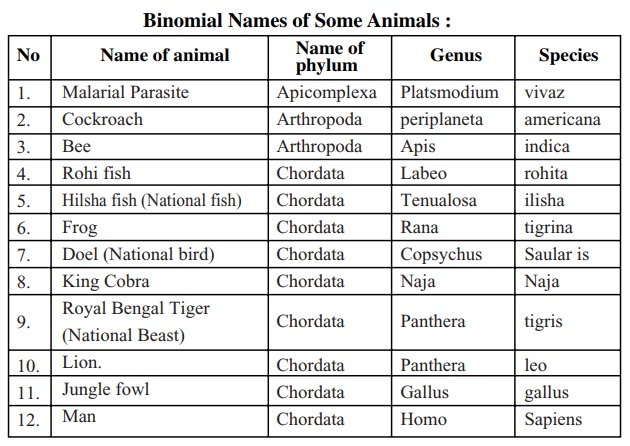
Like animals, unicellular organisms were placed into phylum protozoa. But now they are separated from the animal kingdom and placed in protista or protoctista of 5-kingdom classification. However, as phylum protozoa were a part of the animal kingdom, previously therefore they are still taught in zoology. In the last decade, about the 80's, the International Protozoologist Committee decided that the unicellular protozoans are of vast variety and that they should be included in a single phylum. Thus they have classified protozoans under 7 phyla. In this classification, protozoa is a subkingdom of protista or protoctista kingdom. Among them the amoeba is included in-the phylum Sarcomastigophorea and malarial parasite is in Apicomplexa. The names of nine major phyla of animal kingdom are mentioned below with their
identifying characteristics and examples:
1. Plylum - Sarcomastigophorea Kingdom - Protista
Habit and habitat: The organisms of this phylum are cosmopolitent. Somemembers of these phyla are free living but some are colonial, some lives on damp and wet soil, many species lives in fresh water and marine water. Many members are external or internal parasite of plants or animals, such as (Amoeba) free-living organism of fresh water.
Identifying Characters:
a. Animals of this phylum are unicellular, mic~oscopic. All of functions are perforn1ed by the single cell.
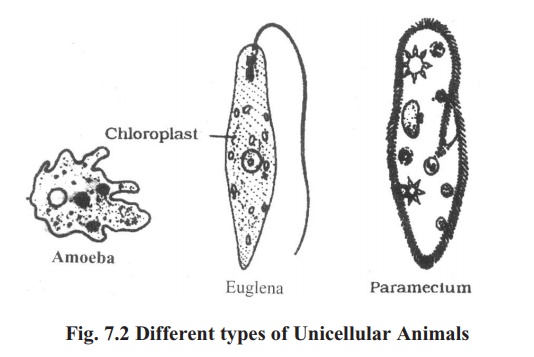
b. They have no cell wall (outside the cell membrane); in the cytoplasm there is a centriole, one vacuole is present, no plastid.
c. They locomote with the help of pseudopodia:
d. They live singly or in colonies.
e. They are free living animals. Example: Amoeba proteus.
Kingdom Animalia:
Habit and habitat: Animals of this phylum are generally known as sponge.They are of different sizes, shape and colour. They are distributed worldwide. In adult stage they live under water. attached with some objects. They live in colonies. They look like a plant. Major members are marine but some live in fresh water.
Identifying Characters:
a) These are simplest multi-cellular animals.
b) There are many small pores or ostia in their bodies
c) Internal circulation is maintained by canal system.
d) There is no separate well-formed tissue, organ or system.
Example: Scypha gelatinosum(Marine sponge).spongilla fragilis(Fresh water sponge)
2. Phylum - Cnidaria
Habit and Habitat: Many members of this phylum live in worldwide in freshwater, drain, canal, river, lake, stream etc. But maximum are marine species. They are of different colour, shapes and sizes; they are the beauty of sea they are attached with floating wood, leaves or something else or free swimming.
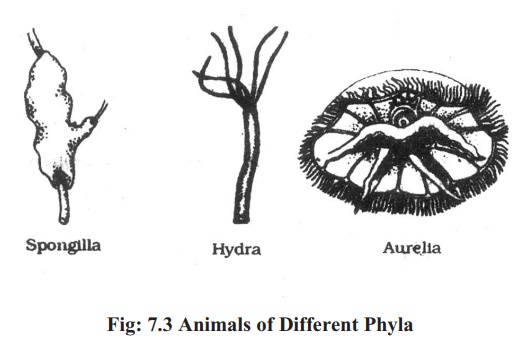
Some species are free living and some are colonial. As: Hydra (fresh water animal) Jelly fish (Marine water animal) and Corals (Marine).
Identifying Characters:
a) They are two layered animals; body is formed of two embryonic celllayers ectoderm and endoderm. Between these two layers there is a non-cellular layer called mesoglea.
b) A body cavity named coelenteron or gastrovascular cavity takes part both in digestion and water circulation.
c) In the ectoderm there are specialized cnidoblast cells. Example: Hydra
Example : Hydra vulgaris, Aurelia aurita.
3. Phylum Platyhelminthes:
Habit and habitat: Members of thisphylum are mainly ectoparasite or endoparasite of other organisms but a few species are free living. They live in fresh water, drain; stream etc. and some species live in saline water, some member of this phylum live in damp and moist soils
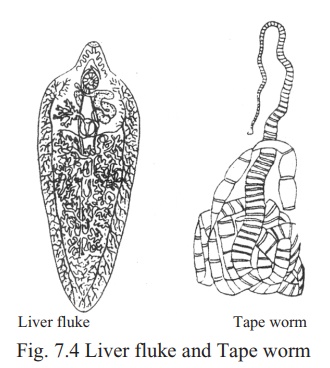
Identifying Characters:
a) They are flat bodied, worm like diocious and mostly endoparasitic animals.
b) Body is covered by a thick cuticle.
c) Sucker or hooks are present.
d) Flame cell is the excretory organ.
e) Digestive system incomplete or absent.
Example: Taenia soliumTape worm Fasciola hepatica liver fluke.
4. Phylum Nematoda.
Habit and habitat: Most members areparasitic. Some of them lives as parasites of plant roots or grains (Wheat. paddy) Intestine, blood and other organs of different animals. some are free living they live in soil and water. On the basis of number they are second largest phylum of animalkingdom.
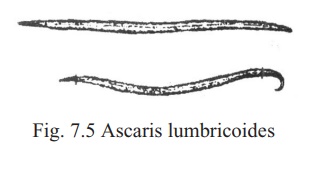
Identifying characters:
a) Body cylindrical, covered with thick cuticle and bilaterally symmetrical.
b) Complete digestive system (Mouth and anal opening present).
c) Body cavity uncovered, there is no true coelom.
d) Circulatory and respiratory system absent.
e) They are generally unisexual.
Ascaris lumbricoides (Round worm)
Ancylostoma duodenale (Hook worm)
Enterobius vermicularis (pin worm)
Rhabditis- free living, Live in soil.
5. Plylum Annelida:
Habit and habitat: Majority of the annelidanimals live in temperate and tropical counties of the world. They show wide diversity in their structure, habit and habitats. Many live in fresh water, saline water. Some occur in moist soil, some members lives in seashore, some in bottomof shallow sea, some species live in grooves on stone and soil.
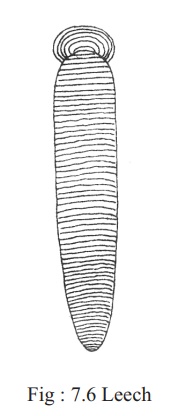
Identifying characters:
a) Body metamerically segmented, body covered with thin cuticle.
b) Ciliated, glandular, coiled tubules named nephridium acts as excretory organ.
c) Generally setae are used as accessory organ for locomotion.
Example: Pheretima posthuma(Earthworm),Tubifex(Live in fresh water.
used as food of aquarium fish Hirudo madicinalis (leech).
6. Phylum Arthropoda:
Habit and habitat: This phylum is. the largest.in animal kingdom. About 60-65% of the known animals belong to this phylum. They are - universally distributed and are adapted to live in almost all types of environments.
Many species are either ecto or endoparasite. They are terrestrial or aquatic. Many of them are capable of flying like cockroach, butterflies,
Bagdaprawn, king crab, spider etc are members of this phylum.
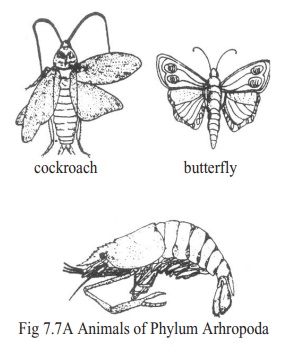
Identifying characters:
a. Body is divisible into different regions, namely head, thorax and abdomen of cephalothorax and abdomen or head and trunk. Appendages of the animals of this phylum are jointed or formed by many segments.
b. Body is covered by cuticle enriched with chitin.
d. In the head there is a pair of compound eyes and antenna.
e.They have blood filled body cavity named haemocoel.
Example: periplaneta Americana (Cockroach) Bombyx mori (Silkworm)
Carcinoscorpius (King crab -a living fossil).
7. Phylum Mollusca:
Habit and habitat: Member of this phylum shows a great variety in structuralorganization, habit and habitat. Most of the members have shells. They are marines and some occur in hilly region and in forest or in plain land. Some species live in different types of fresh water, e.g. snail, octopus and bivalve.
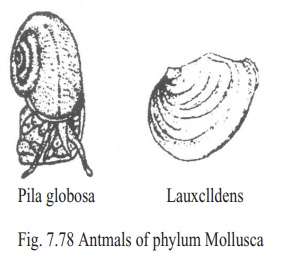
Identifying characters:
a) Body is soft, generally covered by hard shell.
b) Muscular foot present on the ventral side of the body for locomotion.
c) Respiration by gills or lung.
Example: Pila globosa(Apple snail)lamellidens(Bivalve)Octopus vulgaris (Octopus)
8. Phylum Echinodermata:
Habit and habitat: All members of this phylum are marines. None occurs onland or fresh water. Different species of Echinodermata are found in all seas of the world. Majority of them are free living, but some are at the adult stage lead a stationary life.
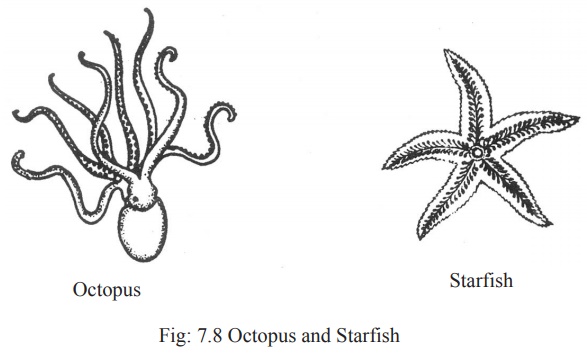
Identifying characters:
a) Integument spinous
b) Body radially symmetrical or can be divided into five similar parts
c) Water vascular system controls the locomotion and respiration
d) In adult animal, head, dorsal and ventral side is not marked clear, oral and aboral surfaces are present.
Example: Asterias rubens(Star fish)Echinus esculentus(Sea urchins)
9. Phylum chordata:
Habit and habitat: Animals of this phylum are found in almost all habitats ofworld. Some species live in land. Among the aquatic chordates some live in fresh water and some in marine water. Many species are arboreal, desert dweller, polar, cave dweller and carsorial. Some members of phylum chordate are ectoparasite on other animals.

Identifying characters:
Through out life or only at the embryonic stage animals of the phylum chordata have four principal characteristics:
1. Notochord: They have in the middle of the dorsal side of the body a soft.flexible. rod shaped, firm, un-segmented structure called notochord, throughout the life or only in embryonic condition. In higher chordates, it.is replaced by bony vertebral column.
2. Nerve cord: A single medium, hollow nerve cord on the dorsal side of bodyis present.
3. Throughout life or at any stage of the life-cycle there are lateral pharyngealgill slits.
4. In case of aquatic chordate body behind the anus modified into a muscular
tail which is accssory organ of locomotion.
Example: Bufo melanostictus(Toad)Crocodylus porosus(saline watercrocodile) Homo sapiens (Man) Bubo bubo (owl) Catla catla (catla fish) Ascidia (Ascidia) Scoliodon (shark) Tenualosa ilsha (Hilsa fish) Mus musculus (Small rat) Bandicota indica (Large rat)
Related Topics